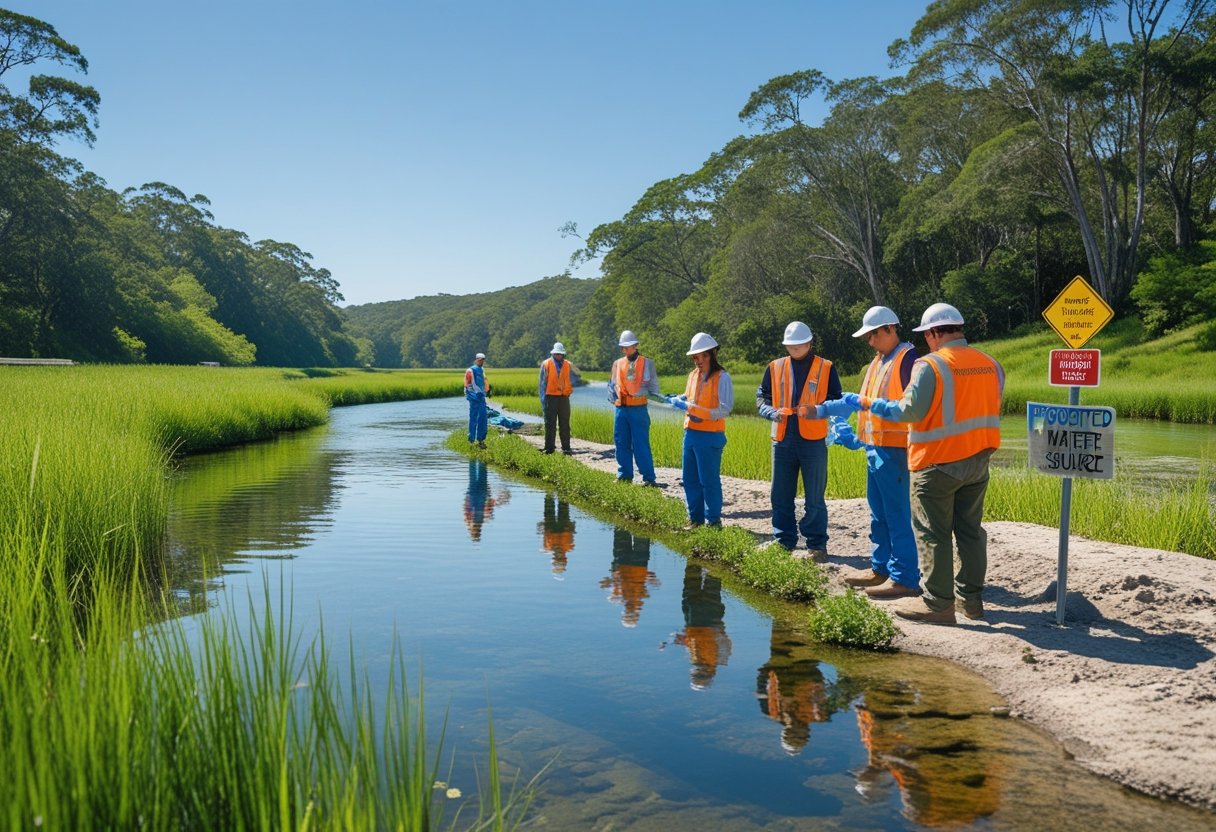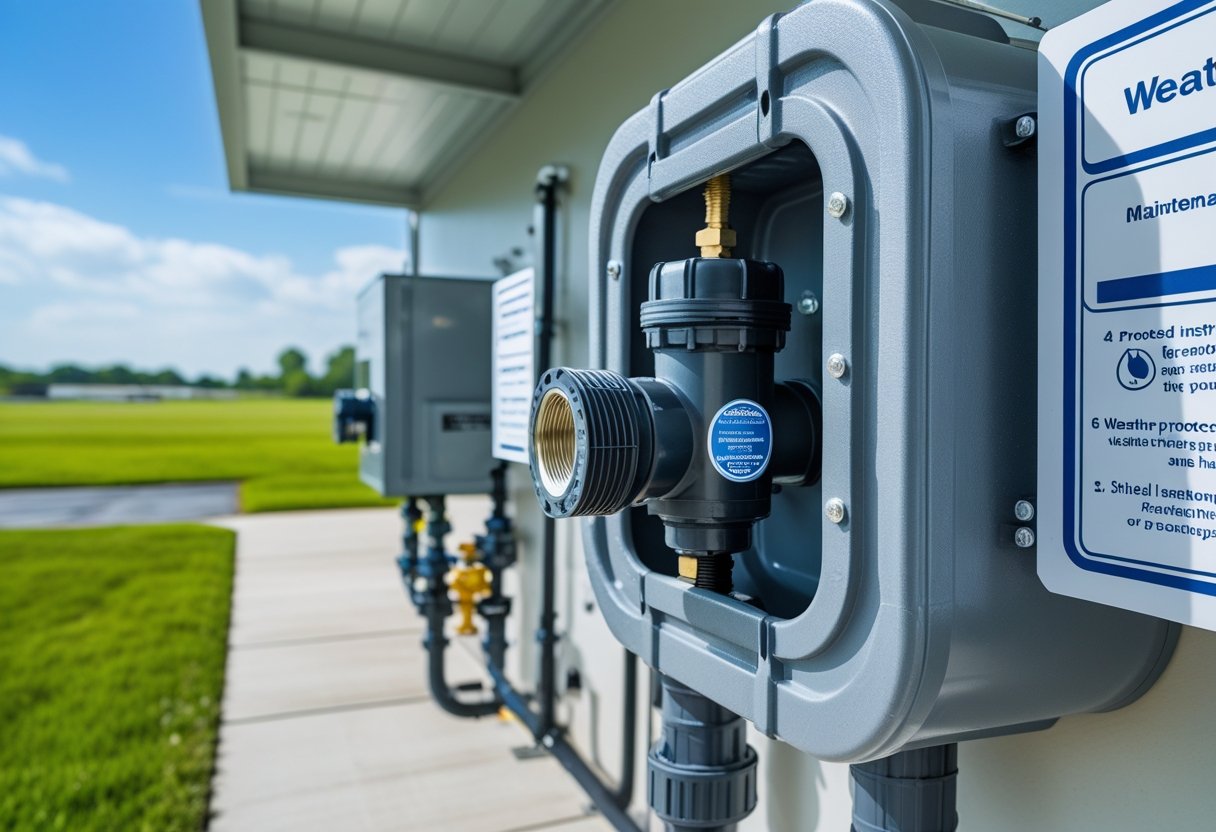Annual backflow testing is important for every homeowner who wants to keep their water safe. It helps make sure your backflow prevention device is working properly, preventing harmful contaminants from getting into your drinking water. This testing is required by many local water authorities, including in San Diego County, where Pacific Backflow offers reliable, fast service to make the process easy for you.
When you get your backflow tested every year, you avoid costly repairs and fines while protecting your family’s health. If there’s a problem, certified technicians can fix it quickly before contamination happens. Trusting professionals like Pacific Backflow means you stay compliant with local rules without any hassle.
Understanding Backflow and Its Risks
Backflow happens when water flows backward into your clean water supply. This can allow harmful substances to mix with your drinking water. Knowing how backflow starts and what dangers it brings can help you keep your home's water safe and meet local rules.
What Is Backflow?
Backflow occurs when water moves in the opposite direction of its normal flow. Normally, water flows from the city supply into your home’s pipes. But if the pressure drops in the main water line, dirty water can flow backward into your clean water. This is called back siphonage.
There are devices called backflow preventers installed in plumbing systems. These stop backflow and protect your water. Testing these devices every year is important to make sure they work well.
Common Causes of Backflow
Backflow can happen in different ways, but the most common causes include:
- Water pressure drops from a main break or heavy water use nearby, which pulls dirty water backward.
- Cross-connections where your home’s water pipes connect with non-potable water sources like irrigation systems or pools.
- Malfunctioning backflow preventers that are broken or worn out.
Regular testing helps catch these problems early before backflow causes contamination. Pacific Backflow offers reliable testing to keep your system working right.
Dangers of Contaminated Water
When backflow happens, harmful substances can enter your home’s water supply. These include:
- Chemicals like pesticides or cleaning fluids
- Bacteria and viruses from sewage or waste
- Pollutants from irrigation or industrial sources
Drinking or using contaminated water can cause health issues like stomach illness and infections. Contaminated water can also damage your plumbing and appliances.
Annual backflow testing helps ensure your water stays clean and safe for your family. It also keeps you following local laws to avoid fines or water shutoff.
What Is Annual Backflow Testing?
Annual backflow testing is a way to make sure your water system is safe and meets local rules. It checks your backflow prevention device to catch any problems that might let dirty water flow backward into your clean water supply. The process involves specific steps, trained people, and proper tools to keep your water safe.
How Backflow Testing Works
Backflow testing checks if your backflow prevention device is working correctly. This device stops water from flowing backward, which can happen when water pressure drops. If dirty water gets pulled back, it can contaminate your clean water supply. During the test, a technician connects special gauges to the device to measure water pressure and flow.
If the device doesn’t hold pressure or allows water to flow the wrong way, it fails the test. Then repairs or replacements are needed to prevent contamination. Testing usually takes less than an hour and happens once a year.
Who Performs Backflow Testing
Certified technicians perform backflow testing. These are trained professionals familiar with local water laws and testing procedures. They inspect your device carefully, perform the test, and fill out official reports required by the city or water district.
Choosing a trusted company is important for accurate results. For example, Pacific Backflow has certified experts who serve all of San Diego County. They handle testing, repair, and reporting to keep your home in compliance without hassle.
Tools Used for Testing
Technicians use specific tools to test backflow devices. The main tool is a test kit with pressure gauges and hoses. These gauges attach to the device’s test cocks to measure pressure drops and ensure valves are working.
Some kits include multiple gauges to check different points on the device. The hoses help connect the gauges securely. Technicians use handheld tools to open and close valves during the test. All equipment must be calibrated properly for accurate readings.
Using the right tools ensures the test shows whether your backflow preventer keeps your water safe.
Key Benefits of Annual Backflow Testing for Homeowners
Getting your backflow prevention device tested every year protects your home in important ways. It helps keep your water clean, stops health problems from developing, and keeps your plumbing safe from damage. These points show why annual testing is worth the time and expense.
Protecting Household Water Quality
Your home's water supply is meant to be clean and safe. Annual backflow testing checks your backflow prevention device to make sure it stops dirty or contaminated water from mixing with your clean water lines. This is very important because changes in water pressure can pull harmful substances into your water.
Without regular testing, your water could get polluted by things like chemicals, bacteria, or waste. This contamination can happen suddenly and without warning. Testing helps you catch problems early and maintains the quality of your water. That way, you and your family can continue to drink, cook, and bathe safely.
Preventing Health Issues
Contaminated water can cause serious health problems. By having your backflow prevention system tested every year, you reduce the chance of harmful germs or chemicals entering your drinking water. This lowers your risk of illnesses caused by bad water, such as stomach bugs and infections.
If your device fails, it could put you and your family at risk. Regular testing gives you early warning so repairs or replacements can happen quickly. This proactive step helps protect your health before any problems start, making sure your water stays safe to use every day.
Preserving Plumbing Systems
Backflow problems can damage your home's plumbing. Dirty water can cause corrosion, block pipes, and lead to expensive repairs. Annual testing ensures your backflow preventer works well and helps avoid these costly issues.
If you wait until a problem appears, repairs will cost more and disrupt your daily life. Keeping your system in good shape with testing helps you avoid leaks, water damage, and plumbing failures. Services like those from Pacific Backflow provide fast testing and repairs to keep your system running smoothly and compliant with local rules.
Ensuring Regulatory Compliance
Keeping up with backflow testing rules helps you avoid problems with your water system. It also prevents fines and keeps your property following local laws, which protect the community’s water supply.
Local Regulations for Homeowners
In California, you must have your backflow prevention device tested every year. This is true for most homes, especially if you have irrigation systems or pools. A certified tester must perform this test.
Your local water authority may have extra rules you need to follow. Testing ensures your device works right to stop contaminated water from flowing back into your clean water.
Failing to test on time can cause complications with your water provider. You should keep records of your test reports. This shows you meet all local regulations.
Avoiding Fines and Penalties
If you don’t test your backflow device yearly, you risk getting fines from your water district. These fines can be costly and increase over time.
Backflow testing keeps your system safe and legal. If your device fails, repairs or replacements are needed quickly to avoid penalties.
Pacific Backflow offers fast testing and files your reports for you. Staying on top of this keeps your home safe and avoids unnecessary fines.
Quick tips:
- Schedule your test early to meet deadlines
- Use certified testers for proper documentation
- Fix any failures right away to stay clean and compliant
Financial Advantages of Annual Backflow Testing
Annual backflow testing saves you money in more ways than one. It helps prevent expensive repairs by catching problems early. It also plays a role in keeping your property’s value steady, which is important if you ever decide to sell.
Reducing Long-Term Repair Costs
By testing your backflow device every year, you stop small issues from turning into big, costly problems. Early detection means you can fix leaks or malfunctions before they damage your pipes or water system. This can save you from expensive emergency repairs that disrupt your home and cost a lot more.
Regular testing also helps you avoid fines from local water authorities. Many places require annual backflow testing, especially if you have irrigation or a pool. Skipping tests could lead to penalties that add unexpected expenses. Pacific Backflow’s certified technicians make this process quick and reliable, minimizing hassle and keeping costs down.
Maintaining Property Value
A well-maintained backflow prevention system shows buyers and appraisers that your home complies with safety rules. This can protect your property's market value. Homes with clean, tested water systems often attract better offers because buyers feel confident the water is safe.
Failing to test regularly may raise concerns about water quality and safety. This can lower your home's appeal or even cause delays during inspection. Keeping your records current, as Pacific Backflow does for you, helps avoid these issues and supports smooth property sales or refinancing.
Environmental Impact
Annual backflow testing helps keep your water clean and safe. It stops harmful substances from entering community water and supports better use of water resources.
Preventing Community Water Contamination
Backflow testing prevents dangerous chemicals, bacteria, and waste from flowing backward into your drinking water. When water pressure drops, dirty water can pull into the clean supply. This risk affects your home and your neighbors.
Testing your backflow device each year makes sure it works right. If it’s broken, contaminants could leak into the water system, putting everyone’s health in danger. Your actions help protect public health by keeping pollutants out of the water.
By using certified technicians, like those at Pacific Backflow, you ensure that testing is done correctly. This keeps your water safe and meets local regulations. It’s a simple way to protect your community’s water supply.
Supporting Sustainable Water Practices
Annual backflow testing also supports wise water use in your area. When your backflow devices function properly, water systems operate more efficiently. This means less wasted water and fewer repairs downstream.
Protecting water quality helps prevent environmental damage. When contaminants don’t enter rivers or groundwater, local plants and animals stay healthy. Clean water supports a stronger ecosystem near your home.
By testing regularly, you help meet state and federal laws designed to keep water fresh and safe for future use. Choosing professional backflow service in San Diego, like Pacific Backflow, means you’re doing your part for the environment while complying with rules.
Choosing a Trusted Backflow Tester
Picking the right backflow tester is key to making sure your water system stays safe and meets local rules. You'll want someone who is skilled, certified, and easy to work with. Knowing what to look for and what to ask can help you find a reliable service.
Tips for Finding Qualified Professionals
Look for testers who are certified by your state or local water authority. Certification means they have the proper training and knowledge to do the job right. Check reviews or ask neighbors if they know a good tester.
Make sure the company offers fast service and handles paperwork for you. This saves time and keeps you compliant with city rules. Ask if they perform a visual inspection and test all parts of the backflow device, such as seals and springs, to catch any worn or damaged pieces.
Choose a company that serves your area well. For example, Pacific Backflow has been helping San Diego County homeowners for decades. Their technicians are experienced and responsive, making the testing process smooth and stress-free.
Questions to Ask Your Service Provider
Before you hire anyone, ask if the tester’s licensed and insured. That’s just basic protection in case something goes sideways during testing or repairs. Also, check if they’ll send the test results directly to your local water authority—some do, some don’t.
Ask how fast they can get the test done once you book. Nobody wants to risk fines or interruptions just because someone’s dragging their feet. If your device doesn’t pass, what then? Do they handle repairs or replacements, or are you stuck shopping around again?
And hey, do they have emergency services if your backflow preventer suddenly fails? It’s a relief knowing there’s help after hours if something breaks at the worst time.
Frequently Asked Questions
Annual backflow testing keeps your water safe and your system running like it should. It also helps you avoid headaches with local rules and surprise expenses.
Why is annual backflow testing important for my home?
Testing makes sure your backflow preventer’s actually doing its job. That way, dirty water can’t sneak back into your clean supply. It’s all about protecting your family’s health.
How can backflow testing contribute to my home's water safety?
It spots leaks or damage early—before they become a real problem. Taking care of issues right away helps prevent contamination, so you can trust your tap water day to day.
What could be the potential consequences of neglecting backflow preventer testing?
Skip the test, and you’re rolling the dice. Pollutants could get into your water, and the local water authority might hit you with fines. Plus, repairs get pricier if you ignore problems for too long.
What does the backflow preventer testing process involve?
A certified technician comes out, inspects, and tests your device. They check the valves and make sure everything’s working as it should. If something’s off, they’ll let you know what needs fixing.
Is it a legal requirement to have my backflow prevention device tested regularly?
Yep. In a lot of places—including San Diego County—yearly testing isn’t optional. Staying on top of it keeps you compliant and your water system up to code.
How often should I schedule backflow testing for my residential plumbing system?
Honestly, it’s a good idea to get your backflow device checked out once a year. Pacific Backflow handles annual testing quickly and reliably, so you can keep your system safe and stay on the right side of the rules.











